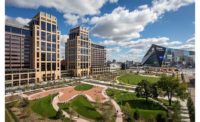Chicago Approves First Use of CLT, Don't Expect High-Rises Anytime Soon

McDonald’s restaurant was allowed to have a CLT deck because it is only one story.
PHOTO BY JEFF YODERS/ENR
The Great Chicago Fire of 1871 gave local building officials the jitters about the use of structural wood in commercial buildings. But a recent installation of cross-laminated timber decking in a one-story McDonald’s may mark a new era, at least for low-rise mass timber.
Although the 19,000-sq-ft McDonald’s marks the first use of CLT in a Chicago building, officials say they are not about to allow tall mass timber buildings any time soon.
Though there has been some fire testing on structural mass timber, “we’re not there yet” in terms of allowing tall mass timber buildings, says John Javorka, chief fire prevention engineer with the Chicago Fire Dept. (CFD) and Bureau of Fire Prevention (BFP).
“We know developers want to go higher with it, [but] there’s not enough testing to really even talk about the concept.”
– Richard Edgeworth, Deputy Fire Commissioner, Chicago Fire Dept.-Bureau of Fire Protection
CLT is a large-scale, prefabricated, solid engineered wood panel consisting of several layers of kiln-dried lumber stacked in alternating directions and bonded with structural adhesives. The McDonald’s is the first use of CLT as a structural material in a Chicago commercial building. Because it’s one level, the building is considered “ordinary construction.” If it were two stories or higher, it would have required a fire protection system. CFD wants more information from established testing labs such as Underwriters’ Laboratories and the National Institute of Standards and Technology (NIST) .
As reported by ENR in March, one of six recent fire tests was designed by the National Research Council Canada (NRC) and conducted at NIST. The test monitored the burn rate of a furnished, 9.1-meter by 4.6-m CLT compartment with an exposed CLT ceiling, 2.7 m high. The test showed the potential for regrowth of a fire within the compartment.
Analysis of the tested CLT revealed that the fire regrowth was the result of a glue line failure due to elevated temperatures near the slowly advancing char front, which resulted in a delamination that exposed uncharred wood that reignited, according to Joseph Su, NRC’s principal research officer for fire safety. The tests, initiated by the National Fire Protection Association’s Fire Protection Research Foundation, were funded by $250,000 from the American Wood Council (AWC) and $175,000 from NFPA’s Property Insurance Research Group. After the delamination and fire regrowth, the International Code Council’s ad hoc committee on tall wood buildings (TWB) requested evidence that CLT can be manufactured with adhesives that cause the product to act like solid wood—which continuously chars to insulate the rest of the member.
CLT manufactured with existing and improved adhesives was tested and demonstrated a satisfactory, non-fire-regrowth performance sought by TWB for use in tall mass timber buildings.
8 STORIES
Carbon12 in Portland, Ore., is the tallest building in the U.S. to use CLT.
Chicago still wants more testing. Javorka and Asif Rahman, deputy commissioner of the Dept. of Buildings, both said that Chicago will wait for fire ratings for products such as CLT. They said such products could require a two-, three- or four-hour fire rating.
“We know developers want to go higher with it, [but] there’s not enough testing to really even talk about the concept. That’s pretty much my position on it,” says Richard Edgeworth, deputy fire commissioner for the CFD-BFP. “The code is not there to deal with it. We’d rather see other places that approved it first, and see what happens over time. I think … a lot of times people just want the look of the wood and we should pause and really look at this deliberatively.”




